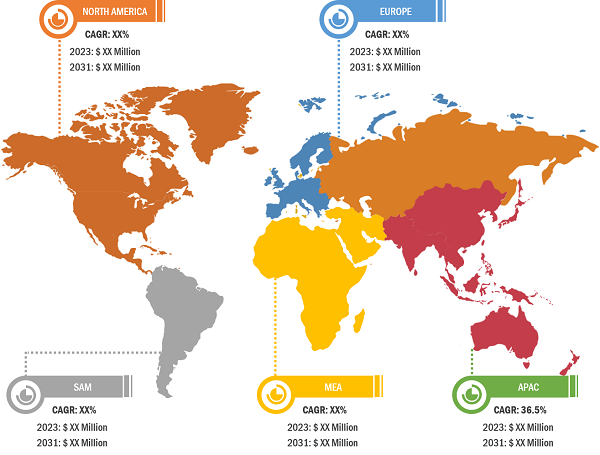Rapid Expansion in Manufacturing Industry Boosts Collaborative Robots Market Growth
According to our latest study titled "Collaborative Robots Market Forecast to 2031 – Global and Regional Share, Trend, and Growth Opportunity Analysis – by Payload, Application, Type, End-User Industry, and Functionality," the market was valued at US$ 1.88 billion in 2024 and is projected to reach US$ 14.67 billion by 2031; it is estimated to register a CAGR of 35.7% from 2025 to 2031. The report includes growth prospects in light of current collaborative robots market trends and factors influencing the market growth.
Technological advancements have further enhanced their safety and adaptability. Collaborative robots now employ a suite of sensors—LiDAR, ultrasonic, and pressure sensors—to map their environment with exceptional precision. This allows them to dynamically respond to changes in their surroundings and avoid collisions with humans or other objects. User-friendly interfaces, such as touchscreens, voice commands, and gesture recognition, have also made these robots more accessible, fostering greater trust and enabling more seamless interaction with human coworkers.
Collaborative Robots Market – by Region, 2024 and 2031
Collaborative Robots Market Size and Forecast (2021 - 2031), Global and Regional Share, Trend, and Growth Opportunity Analysis Report Coverage: By Payload (5–10 Kgs, Up to 5 Kgs, and Above 10 Kgs), Application (Assembly, Pick and Place, Material Handling, Quality Testing, Machine Tending, Welding, Packaging, and Others), Type (Robotic Arm, Welding Guns, Grippers, and Others), End-User Industry (Automotive, Electronics, Metal and Machinery, Food and Beverage, Logistics, Pharmaceuticals, and Others), Functionality (Static Robot and Mobile Robot), and Geography
Collaborative Robots Market Size, Growth & Forecast 2031
Download Free Sample
Source: The Insight Partners Analysis
The global manufacturing industry is rapidly expanding as more and newer regions invest in manufacturing plants in their localities. This expansion is expected to embrace technological advancements to enhance plant productivity, maintain an edge with customers, and gain a competitive advantage. The expansion in the manufacturing industry is further driven by economic growth worldwide. Also, the industry is presently found to be in the middle of a technological renaissance, which is changing the outlook, systems, and processes of the modern factory. This technological revolution in the factories has been encouraging the manufacturing industries to further invest in these emerging technologies to enhance their productivity and production cycle. Thus, the rapid expansion in the manufacturing industry drives the collaborative robots market growth globally.
The collaborative robots market analysis has been carried out by considering the following segments: payload, application, type, end-user industry, and functionality. Based on payload, the market is segmented into 5–10 kgs, up to 5 kgs, and above 10 kgs. By application, the market is categorized into assembly, pick and place, material handling, quality testing, machine tending, welding, packaging, and others. In terms of type, the market is divided into robotic arm, welding guns, grippers, and others. In terms of end-user industry, the market is segmented into automotive, electronics, metal and machinery, food and beverage, logistics, pharmaceuticals, and others. By functionality, the market is divided into static robot and mobile robot. The static robot segment held a larger collaborative robots market share in 2024.
The scope of the collaborative robots market report is primarily divided into North America (the US, Canada, and Mexico), Europe (Spain, the UK, Germany, France, Italy, and the Rest of Europe), Asia Pacific (South Korea, China, India, Japan, Australia, and the Rest of Asia Pacific), the Middle East & Africa (South Africa, Saudi Arabia, the UAE, and the Rest of Middle East & Africa), and South & Central America (Brazil, Argentina, and the Rest of South & Central America). Europe accounted for the largest collaborative robots market share in 2024. Europe has several major manufacturing industries, such as aerospace, machinery & equipment, automotive, shipbuilding, and military vehicles. The automotive industry of the EU is considered to be a crucial industry as it significantly contributes to the country's GDP (6.8%). EU is the leading producer of motor vehicles, and several premium automotive manufacturers are based in the region. Furthermore, the automotive sector in the region represents the largest private investor in research and development, as well as it receives support from the government—such as funds for research and development. The vehicle manufacturing industry is a strategic industry for accelerating the collaborative robots market size, as it produces ~19.2 million cars, vans, buses, and trucks per year. Also, ~300 vehicle assembly and manufacturing facilities are located in 26 countries across the region.
Kuka AG; Yaskawa America Inc; Aubo (Beijing) Robotics Technology Co Ltd; Doosan Robotics Inc; Fanuc Corp; ABB Ltd; Rethink Robotics GmbH; Techman Robot Inc; Kawasaki Heavy Industries Ltd; Bosch Rexroth AG; Teradyne Inc; Denso Corp; Comau SpA; SIASUN Robot & Automation CO., Ltd; Agile Robots SE; Azenta, Inc.; Svaya Robotics Pvt. Ltd.; Productive Robotics, LLC; and ESTUN AUTOMATION CO., LTD. are among the key players profiled in the collaborative robots market report.
Contact Us
Phone: +1-646-491-9876
Email Id: sales@theinsightpartners.com